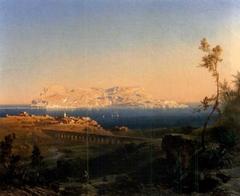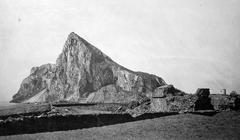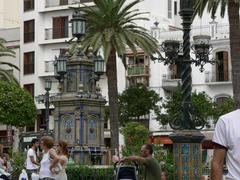Fuerte de San García Visiting Hours, Tickets, and Historical Insights
Date: 01/08/2024
Introduction
Fuerte de San García, located in Algeciras, Spain, stands as a testament to the region’s strategic military history and cultural heritage. Constructed in the 1730s, the fort was part of a network of coastal defenses designed to protect the Strait of Gibraltar from British incursions following the conquest of Gibraltar in 1704 (source). Its location at Punta de San García enabled it to control maritime traffic and safeguard the coastlines from Getares to Playa de El Chinarral and Algeciras (source). The fort’s robust architectural design, which included barracks, a powder magazine, and strategic artillery placements, reflects the military engineering prowess of its era (source). Despite its destruction during the Peninsular War to prevent its capture by Napoleon’s forces, the remains of Fuerte de San García have been preserved and integrated into the Parque del Centenario, offering visitors a poignant glimpse into the past (source). This comprehensive guide provides essential information for visitors, including historical insights, visiting hours, ticket prices, and travel tips, ensuring a memorable and informative experience.
Table of Contents
Historical Background
Construction and Early Purpose
Fuerte de San García was constructed in the 1730s as part of a series of fortifications aimed at defending the coast of the Strait of Gibraltar from British incursions. This strategic location was crucial following the British conquest of Gibraltar in 1704. The fort was situated at Punta de San García, south of Algeciras, and played a significant role in controlling maritime traffic from the cove of Getares to Playa de El Chinarral and subsequently to the city of Algeciras (source).
Architectural Features
The fort was designed to accommodate a garrison of twenty men, including an officer, a corporal, a sergeant, and the necessary artillerymen. It featured both infantry and artillery barracks with sufficient capacity for the stationed troops and potential reinforcements during wartime. The powder magazine was located within the northern bastion, protected by a thick wall, while the armory was strategically placed near the barracks for quick access in emergencies (source).
Strategic Importance
Fuerte de San García was part of a broader network of coastal defenses that included other forts such as Fuerte de Punta Carnero and Fuerte de Isla Verde. These fortifications worked in unison to slow down enemy fleets approaching Algeciras and hinder their retreat. The fort’s artillery included up to five 24-pounder cannons, one 18-pounder cannon, and two mortars, which were strategically positioned to cover various directions and prevent landings on the coast beneath the fort (source).
Destruction During the Peninsular War
In 1810, during the Peninsular War, the Spanish fortifications around Gibraltar, including Fuerte de San García, were destroyed to prevent their use by Napoleon’s forces. The main Spanish lines were demolished by Colonel Sir Charles Holloway on February 14, 1810. Following the primary explosion, other towers were also destroyed, and volunteers removed the rubble (source). The fort itself was destroyed in 1811 by British sappers to ensure it did not fall into French hands (source).
Post-Destruction and Archaeological Significance
Today, the remains of Fuerte de San García are preserved as an archaeological site within the Parque del Centenario. The site includes the foundations and base ruins of the fort, which have been excavated and partially restored. Despite the destruction, the layout of the fort is still visible, although none of its walls reach a meter in height. The tower, which was part of the original fortifications, is barely discernible, with only a faint outline of its base remaining (source).
Restoration Efforts
In 2006, the Port Authority of the Bay of Algeciras undertook restoration efforts as part of the centennial celebrations of the creation of the Junta de Obras del Puerto. These efforts aimed to preserve the historical significance of the site and make it accessible to visitors. The restoration included clearing the site, stabilizing the remaining structures, and installing informational plaques to educate visitors about the fort’s history and significance (source).
Cultural and Historical Recognition
Fuerte de San García is recognized as a Bien de Interés Cultural (BIC), a designation that highlights its cultural and historical importance. This status ensures that the site is protected and preserved for future generations. The fort’s remains serve as a poignant reminder of the region’s turbulent history and the strategic importance of the Strait of Gibraltar (source).
Integration into Parque del Centenario
The fort’s remains are now integrated into the Parque del Centenario, a public park that offers visitors a chance to explore the historical site within a natural setting. The park provides a unique combination of historical education and recreational opportunities, making it a popular destination for both locals and tourists. Visitors can walk along the trails, enjoy the scenic views of the bay, and learn about the fort’s role in the defense of Algeciras (source).
Visitor Information
Visiting Hours
Fuerte de San García is open to visitors every day from 10:00 AM to 6:00 PM. It is advisable to check the official website before planning your visit to confirm the current visiting hours as they may vary seasonally.
Ticket Prices
Entry to Fuerte de San García is free of charge. However, donations are welcomed to support ongoing restoration and maintenance efforts.
Travel Tips
- Transportation: The site is accessible by car, and parking is available nearby. Public transportation options include buses that stop close to the park entrance.
- Best Time to Visit: The best time to visit is during the spring and fall when the weather is mild. Early mornings and late afternoons are ideal to avoid crowds.
- What to Bring: Comfortable walking shoes, water, and a camera are recommended. Sunscreen and hats are advisable during the summer months.
Nearby Attractions
Algeciras is home to several other historical sites worth visiting, including the Fuerte de Punta Carnero, Fuerte de Isla Verde, and the city’s Old Town. The nearby beaches, such as Playa de El Rinconcillo, also offer a relaxing break from sightseeing.
Accessibility
The site is partially accessible to visitors with mobility issues. While some areas may be challenging due to uneven terrain, efforts have been made to improve accessibility where possible.
Special Features
Special Events
Occasionally, Fuerte de San García hosts special events, such as historical reenactments and cultural festivals. These events provide a deeper insight into the fort’s history and are a great way to experience the site in a unique way.
Guided Tours
Guided tours are available upon request. These tours are led by knowledgeable guides who provide in-depth information about the fort’s history, architecture, and strategic importance.
Photographic Spots
The fort and its surroundings offer several excellent photographic opportunities. The panoramic views of the bay and the remnants of the fortifications make for stunning backdrops.
FAQ
Q: What are the Fuerte de San García visiting hours?
A: The fort is open daily from 10:00 AM to 6:00 PM. Check the official website for seasonal variations.
Q: How much do Fuerte de San García tickets cost?
A: Entry is free, but donations are appreciated.
Q: What should I bring when visiting Fuerte de San García?
A: Comfortable walking shoes, water, a camera, sunscreen, and hats during summer months.
Q: Are guided tours available?
A: Yes, guided tours are available upon request.
Conclusion
Fuerte de San García stands as a significant historical and cultural landmark in Algeciras, Spain. Its well-preserved structure, rich history, and strategic location make it a must-visit destination for anyone interested in the maritime and military history of the region. From its construction in the 1730s to its destruction during the Peninsular War, the fort played a crucial role in the defense of the region. Today, its remains serve as an important cultural and historical landmark, offering visitors a glimpse into the past and the opportunity to appreciate the rich history of Algeciras.
Call to Action
Plan your visit to Fuerte de San García today and immerse yourself in the history of Algeciras. Don’t forget to check out our mobile app Audiala for more travel tips and updates. Follow us on social media for the latest news and events.
References
- Wikipedia. (n.d.). Fuerte de San García. Retrieved from https://es.wikipedia.org/wiki/Fuerte_de_San_García
- Tudestino. (n.d.). What to See in Algeciras. Retrieved from https://www.tudestino.travel/andalusia/province-of-cadiz/algeciras-en/guide/what-to-see-in-algeciras/




